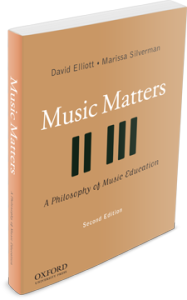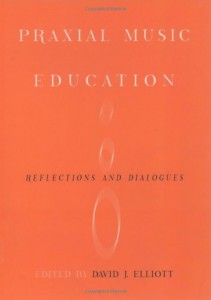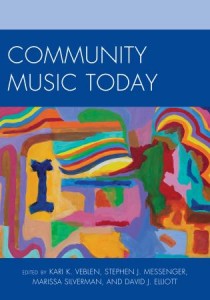The year 2005 marks my third year as a New Yorker, my thirty-second year as a professor of music education, my fifty-sixth year as a white, male, Canadian (of Irish heritage), and my fiftieth year as a performer, composer, arranger, and golfer. Other aspects of my personal identity include my years as a youthful hockey player, an ardent student of history and philosophy, a writer, a speaker, a lover of visual art and dance, and some other things.
During this time, I’ve most often found my comfort level in fairly detached analyses and scholarly expositions. I think that friends who know me well would call me socially affable, but away from work I’m actually a fairly private person, spending much time quietly reading, listening to recordings, or playing golf. And so it’s sometimes difficult for me to take personal risks in writing about my inner thoughts and conflicts, and the situations that prompt them. What I’ve just written here is one of the only times I’ve ever stated this much in print.
For these reasons, I find O’Toole’s essay (PME, chapter 16) important and moving, knowing that she is putting her-self-identity “out there,” personally and professionally. I particularly appreciate her sincerity in speaking her individual truths about the circumstances of her teaching, whether observing the MUSE program in Buffalo, teaching 5th and 6th graders, or working with a university choir, and a tradition bearer.
I want O’Toole and like-minded colleagues to feel at home with the praxial orientation, so it’s disappointing to me that she doesn’t feel this way. I believe deeply that issues of gender, race, and class are central to music, music education, community music (see Veblen’s essay chapter 17), and social life. I believe I put the selfhood and self-identity of the individual student at the center of MM by devoting major sections of the book to self-growth, self-knowledge, critical reflection, and cultural identity, as I’ve reviewed in previous sections of this web site. Also, for example, Woodward offers this view: “As Elliott suggests, to begin with, every child should be immersed in the music of his or her own culture. A child’s music is his or her identity, his or her natural musical home” (PME, p. 257). Still, I admit that I did not address the issues of gender, race, and class as directly and deeply as I should have. I need to rectify this deficiency when I write a new edition of MM.
To take another tack now, however, let me offer some reflections on the nature of identity. I will follow these thoughts with some points I think O’Toole and I may agree on, despite her words to the contrary.
Philosophers often discuss “identity” in terms of the conditions of change under which something can be said to remain the same. In contrast, psychologists usually use “identity” in reference to a person’s sense of self and the personal attributes and external relations that are individually defining. For example, and briefly, Plato and Aristotle explored the concept of identity in terms of change. They asked: how can something that goes through either mutation or growth be considered the same thing? Both concluded, perhaps differently, that human beings have an inner substance or “soul” which remains constant throughout physical change. Hegel, on the other hand, viewed identity in terms of social activity. He noticed that our sense of self arises from our interactions with others. For Hegel, the social foundations of identity include such matters as race, nationality, class, and culture.
But are there other influential aspects of identity, such as ethnicity, national affiliation, or economic status that may remain while others “shift”? In The Cultural Nature of Human Development, Rogoff (2003) observes that “people’s cultural participation is often discussed in terms of cultural or ethnic ‘identity,’ asking Who are you? or What are you?” (p. 77). Consider, for example, that people of the Asian race remain Asian even though they may live in Korea, Thailand, Canada, Japan, or New Zealand, and/or even though they may be lawyers, teachers, musicians, or doctors whose salaries change over time, and/or even though they may be Christians, Buddhists, and so forth. As Fornäs (1995) writes:
“Cultural practices create cultural identities: symbolic patterns or ordered sets of signs which interact both with subjectivities and with social communities. Neither social nor subjective identities can be directly observed. A person’s collective belonging or inner self is not in itself clearly visible for another person . . . Cultural identities are specific structured units in our symbolic interaction with which we construct, designate or characterize collective (social) as well as individual (psychological) identities. Cultural identities thus mediate between the external and the internal, and between the objective, the social and the subjective. But they simultaneously form an arena of their own, a symbolic order with specific codes and processes.” (pp. 179-80)
So, our identity and/or our selfhood and self-growth have several components. For example, in MM I explained how self-growth, self-identity, and enjoyment emerge from students learning to make and listen to music in the social-cultural context of “others” (e.g., teachers, peers, heroes, legends, lore, valued works) as these emerge differently in specific musical practices (e.g., jazz practices, Irish music practices, Baroque choral and instrumental practices). I note that O’Toole says somewhat the same thing in relation to the music-teaching examples in her essay. Indeed, the self is personal-social, encompassing who we are individually and in relation to other people in our lives. For purposes of reflection, we could say there is the material self that relates to our body, possessions, family, and home. But there is another aspect of selfhood and identity: the spiritual self or, in other words, a person’s inner or subjective being. William James referred to this as “pure Ego,” which arises from one’s stream of consciousness. He writes: “Resemblance among the parts of a continuum of feelings (especially bodily feelings) . . . constitutes the real and verifiable ‘personal identity’ which we feel” (1890, vol. 1, pp. 334-336).
Praxial music education conceptualizes “identity” in terms of the fluid connections between the student’s personal, psychological, social, cultural, and bodily self, all of which develop in the context of the educational community or “belongingness” that I call the curriculum-as-practicum, which has self-growth and enjoyment as its center.
Closely related to what I’ve just said are sections in MM where I suggest that “each mini-world on its own (i.e., the jazz-choral world, the Baroque world, and so on), rests on musical-social traditions and standards that provide students with knowledge about who they are and what they can do in relation to themselves, to each other, and to past others” (p. 180). I go on to explain that students who participate in learning, maintaining, and contributing to musical practices (as adult listeners and/or amateur music makers) gain what philosopher Alistar MacIntyre calls the “internal goods” of a practice, including, most importantly, “a certain kind of life.” Sparshott’s term is Lebensform: a “form of life.” Moreover, when teachers induct children into musical practices as active, reflective practitioners, they speed a child toward “a system of meanings that gives purpose to one’s being” (MM, p. 180) Thus, music becomes an important part of a student’s “life themes.” As Damasio (1999) writes: “The idea each of us constructs of our self, the image we gradually build of who we are physically and mentally, of where we fit socially, is based on autobiographical memory over years of experience and is constantly subject to remodeling” (p. 224).
O’Toole’s essay begins by highlighting the words of Christopher Small who locates musical meaning by “centering on relationships in music – relationships between person and person, between person and society, between humanity and the natural world, etc.” I hope it’s clear from what I’ve just said above that I agree completely with Small and O’Toole, and that my statements in MM evidence my agreement, though I did not emphasize the sociality of musical events to the degree that Small does. His insights are profound in this regard.
However, and in view of what I’ve explained in several other sections of this web site, I suggest it is quite incorrect to say that I am mostly concerned with the “technical and performative aspects of musicing” (PME, p. 297), that I limit musicing to performers, that I have “a separate category for listeners,” and that the praxial philosophy “does not include any other kind of participant in music or music education nor the identity issues Small addresses” (p. 299). These statements fail to consider major portions of MM that provide evidence to the contrary. For example, and addition to what I’ve already said in previous sections of this site, O’Toole’s statements omit to consider the several kinds of musicing I discuss (see, for example, MM, chapter 7), and the praxial emphasis on engaging all students in creativity and interpretation (see MM, chapter 9), all of which I link to listening. Interestingly, Burnard denies O’Toole’s viewpoint:
“. . . it is important to remember that the praxial philosophy encompasses all manner of participation – listening, composing, improvising, arranging, performing, conducting – as music making situated in the mainstream of one’s own experiences.Young people are embroiled in varied living and musical cultures operating outside school. The praxial philosophy acknowledges the many musics of the world and the musical worlds of young people” [italics added]. (p. 271)
Burnard add this: “Elliott validates the actions and intentions of all people present in a musical setting. In this view, it is everyone, together, as a collective, who shapes musical courses of action and response” (p. 272).
Indeed, I share O’Toole’s enthusiasm for the MUSE program and the choirs she describes in her essay (I give similar examples in MM), and I passionately support other examples of these kinds of community music education. I’ve taught in these same kinds of situations and contexts. And as I explained in my discussion of multicultural music education, learning other musics through all forms of musicing and listening is crucial if we want to make our profession a humanistic and self-affirming enterprise wherein students explore and construct their identities in relation to the identities and values of others. In fact, as Veblen confirms (PME, chapter 17), I’ve spent several years encouraging and documenting the kinds of “nontraditional” music-teaching programs that music-gender scholars like O’Toole support. So again, we agree on several very important matters.
To bring up another claim: “Elliott’s language in Music Matters encourages dismissal of nontraditional ways of musicing” (PME, p. 300). Regelski makes a similar point in his essay when he says that my idea of praxis “appears to stress existing types of music more than, or in preference to, the social groundedness of music” (PME, p. 229). He continues:
If this is the case, it fails to sufficiently acknowledge that different types of music (jazz, rock, “art music,” etc.) have evolved according to certain use-functions (needs, intentions, interests, benefits, “goods,” etc.) and continue to serve various functions in the present – though not always in the ways connected with the originating conditions. (p. 229)
I acknowledge that I should have said more on these matters. But if readers review what I say throughout the whole of MM, they will see that I discuss and refer to many kinds of “nontraditional” musicing, including these: rap, West African drumming, Balinese keybar, Korean kayagum sanjo, Ottoman peshrev, the sacred songs of the Australian Pitjantjara peoples, Zulu songs, Arab maqam, Iranian radif, Sardinian launeddas, jazz, soft rock, pop, country and western music, and so on. Moreover, I cite ethnomusicologist Tim Rice to affirm my concern for the variability of musical meanings, the fluidity of musical practices, and the ways people construct meaning and identity in and through music:
“the acts of creating, performing, and appreciating music are not simply exercises in pure form or pure production. The creating of music always involves an act of appropriation and interpretation of traditional procedures and images. These images and procedures are historically meaningful, socially meaningful, and individually meaningful . . . . Music receives its meaning through unending interpretations by individuals in the world. That world, the world in which music has meaning, is our world . . .” (MM, p. 143)
Permit me to engage another issue: that MM does not provide explicit examples or discussions on “such subject positions as race, class, gender, sexuality, patriarchy, consumerism, age, and ability” (p. 300). Is this true? Not completely. I do offer explicit examples of gender and sexuality, as in this excerpt from my discussion of music listening (MM, chapter 8): “what rock songs share in common with musical works from many other times and places, including nineteenth century Romantic works, is a tendency to develop musical expressions of human physicality that invite listeners to experience their own physicality (and sexuality) in various (and often new) ways” (MM, pp. 193-194). I follow these words with more from Susan McClary:
“to say that one hears sexual longing in the Tristan prelude is not to introduce irrelevant ‘subjective’ data into the discussion. Surely that is the point of the opera, and we are missing the point if we fail to understand that. The process by which Wagner’s music accomplishes this is not at all mystical. In part, his music draws on his own (excessively documented) experiences in the sexual realm, and we as listeners perceive longing in his music likewise because we are human beings with bodies who have experienced similar feelings firsthand . . .” (MM, p. 194)
I go on to point out how Madonna (for example) takes sly pot-shots at female stereotypes and how Madonna’s singing is linked to a long history of narrative vocal music that places emphasis on female expressions of both the spiritual and the erotic in the traditions of Bessie Smith, Billie Holiday, Aretha Franklin and others (MM, pp. 194-195).
So, while much of my thinking on these topics is not developed at length in MM, it’s inaccurate to say that I fail to mention any. Still, I concede that I must say much more in the future. In fact, music educators (me included, of course!) must make up for our failings by correcting, critiquing, expanding, and becoming activists for our theorized practice in relation to the contexts that authors such as O’Toole discuss so perceptively: gender as context, sexuality as context, and race as context, to name a few. Additionally, I believe there’s another context that bears examination in music teaching and learning: nationalism. For example, issues and tensions that surface so strongly in America are drawn and renegotiated very differently in Canada, Finland, the UK, Ireland, and so forth. Through deeper and broader comparative studies, we can probe the ways our national music education contexts and organizations shape, restrict, or distort our theorizing in terms of past or present themes, problems, fictions, slogans, and histories (e.g., “National Standards”).




Pingback: The Personalization of Music | ahokiecares